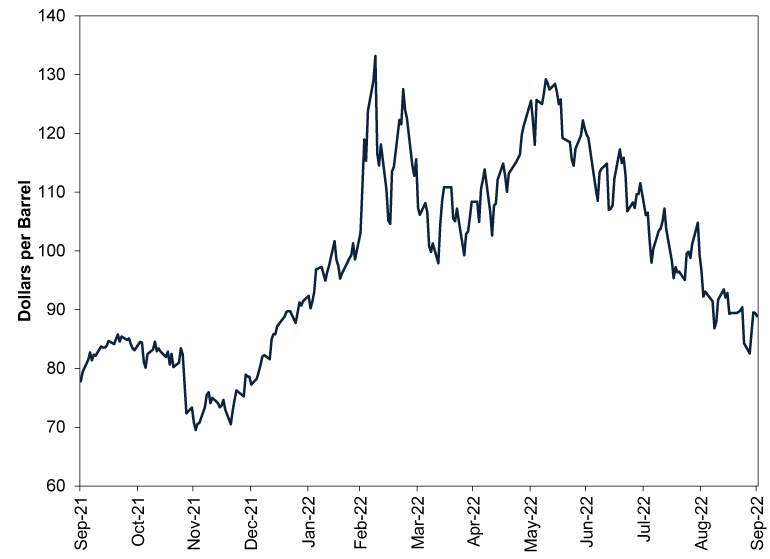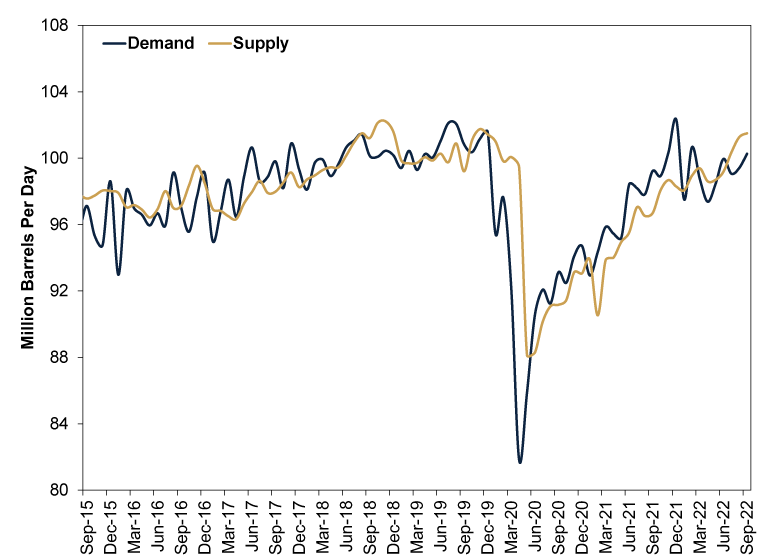Personal Wealth Management / Market Analysis
OPEC’s Cut in Perspective
Global supply is up big this year despite OPEC’s failure to meet production targets.
Crude oil prices jumped on Wednesday, closing at $94.68 after the Organization of the Oil Exporting Countries (OPEC) and its partners reduced their production target by two million barrels per day (bpd) at this week’s meeting.[i] Financial commentators we follow warn production cuts will drive global oil prices higher and exacerbate this year’s inflation (broadly rising prices across the economy), compounding extant economic headwinds. Whilst we think this conforms to standard economic logic, considering prices move on supply and demand, we also think it is quite out of step with how oil supply and demand—and oil prices—have behaved since Russian President Vladimir Putin’s troops invaded Ukraine.
Exhibit 1 shows global oil prices this year to date. As you will see, crude rose in the run-up to the invasion and spiked just afterward, reaching its year-to-date high on 8 March.[ii] That, you might recall, is the day the UK announced its decision to ban Russian oil imports, heightening warnings of a sudden supply crunch. But since summer, oil has declined steadily as it became apparent that Russian oil was finding buyers and global supply was resilient. Oil prices now sit right around pre-Ukraine war levels.[iii]
Exhibit 1: Brent Crude Oil in 2022

Source: FactSet, as of 6/10/2022. Brent crude oil spot price in USD, 30/9/2021 – 30/9/2022.
If our interpretation of financial headlines is any indication, oil’s decline isn’t widely appreciated. We suspect that is because earlier high oil prices are still feeding into consumer price inflation—not just from the comparison with lower petrol and household energy prices a year ago, but from all the consumer products that use oil and gas as building blocks (or feedstocks if you prefer the technical term). The production economy has faced many challenges this year, and our read of corporate executives’ comments at earnings conference calls suggests not all companies passed those costs onto consumers immediately. So when consumers hear about oil production cuts and the potential for rising prices, we imagine it is very easy to mentally layer that on top of the current inflation rate and presume it will keep accelerating indefinitely, not accounting for the reduced price pressures that we think have been at work since summer in the form of lower commodity prices and easing shipping bottlenecks.[iv]
Then again, we think it is a stretch to extrapolate OPEC production cuts to an oil price spike. Like all assets, oil moves on supply and demand. As Exhibit 2 shows, supply has outstripped demand for a few months now, to the tune of about 1.3 million bpd in September. That exceeds OPEC’s headline production target cut, but that doesn’t mean actual production will fall by two million bpd. As we will explain further in a moment, OPEC is cutting production quotas that it has undershot by a wide margin recently, which is why analysts project actual production cuts will be more in the neighborhood of one million bpd, which would bring supply and demand roughly into balance.[v] It seems to us like the cartel may be aiming to put a floor under recently declining prices. That might end the recent slide, but it doesn’t automatically mean another spike, especially with consumption down from last autumn’s high, when the world was gobbling up oil as a replacement fuel when European wind production tumbled and coal was in short supply in China.
Exhibit 2: The World Has an Oil Surplus

Source: FactSet, as of 3/10/2022. Monthly global oil supply and demand, September 2015 – September 2022.
Note, too, that supply has risen (and prices declined) despite OPEC’s chronic failure to meet its targets. Yes, failure. According to a widely reported leak of some OPEC internal documents, OPEC and its partners (including Russia and others) missed August’s production target by 3.58 million bpd.[vi] That is even worse than July, when production was reportedly 2.9 million bpd before the target due primarily to attacks on Nigeria’s oil infrastructure and Russia’s production cuts in the wake of sanctions, and it extends a long-running miss. Again, cutting a target, which is what was agreed Wednesday, is different than cutting actual output.
In our experience, OPEC always attracts most of the world’s attention, but that seems like mostly a relic of the 1970s, when the cartel demonstrated real power to control supply. That was before the shale boom, when US production surged, leading to a global supply glut in the mid-2010s that the world took a few years to work off.[vii] Our research suggests it also took US oil producers several years to work through that era’s over-investment and debt accumulation, which is one reason why they have been slower to ramp up this time around. But US production is nevertheless up, from a pandemic-era low of 9.7 million bpd in May 2020 to a post-pandemic high of 11.8 million in July, the latest data available.[viii] With US oil rig counts up by over 100 this year to date, production likely continues rising, potentially counterbalancing any further OPEC production cuts from here.[ix]
In our view, oil prices aren’t a fundamental stock market driver. Our research suggests oil and stocks move concurrently, as all similarly liquid assets do, digesting the same information—one doesn’t predict the other. But we think high oil prices have affected sentiment this year, so from that standpoint, falling uncertainty in the oil world probably benefits stocks as it gradually arrives. The more the world sees supply and demand staying roughly balanced despite OPEC’s rumblings, the more we think uncertainty should fall.
[i] Source: FactSet, as of 6/10/2022. Brent crude oil spot price in USD, 4/10/2022 – 5/10/2022.
[ii] Ibid. Brent crude oil spot price in USD, 31/12/2021 – 6/10/2022.
[iii] Ibid.
[iv] Source: FactSet and the Federal Reserve Bank of New York. Statement based on Global Supply Chain Pressure Index, as of 5/10/2022.
[v] Source: Fisher Investments Research, as of 5/10/2022.
[vi] “OPEC+ Is Now 3.6 Million BPD Below Its Oil Production Target,” Tsvetana Paraskova, OilPrice.com, 19/9/2022.
[vii] “How The Shale Boom Turned the World Upside Down,” Robert Rapier, Forbes, 21/4/2017.
[viii] Source: US Energy Information Administration, as of 3/10/2022.
[ix] Source: FactSet, as of 3/10/2022.
Get a weekly roundup of our market insights.
Sign up for our weekly e-mail newsletter.

You Imagine Your Future. We Help You Get There.
Are you ready to start your journey to a better financial future?

Markets Are Always Changing—What Can You Do About It?
Get tips for enhancing your strategy, advice for buying and selling and see where we think the market is headed next.



